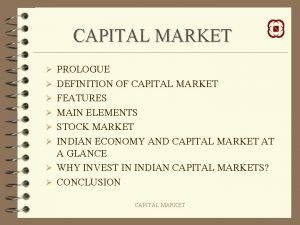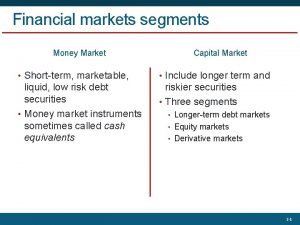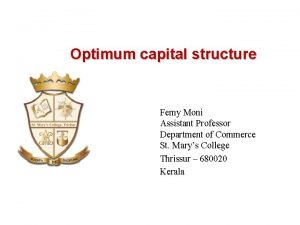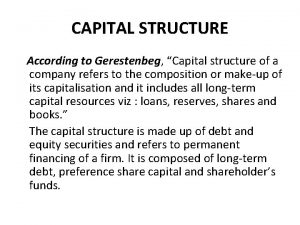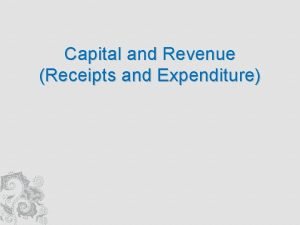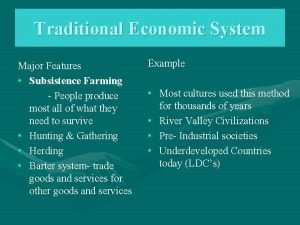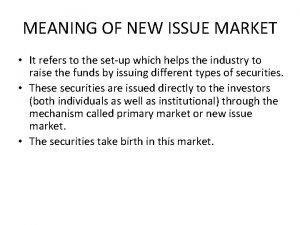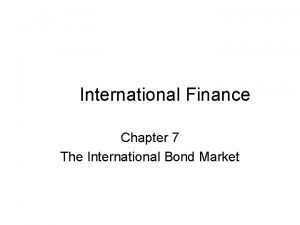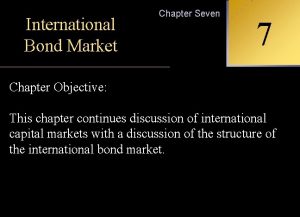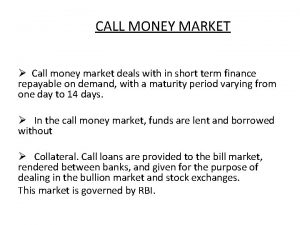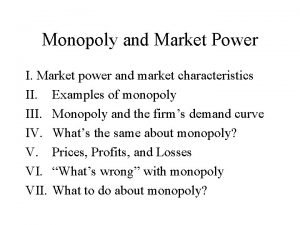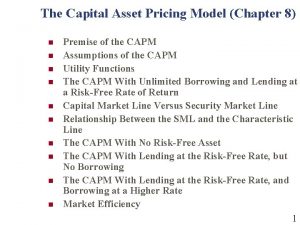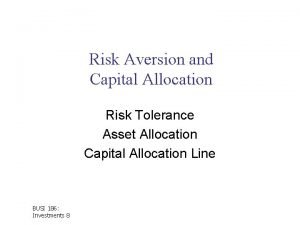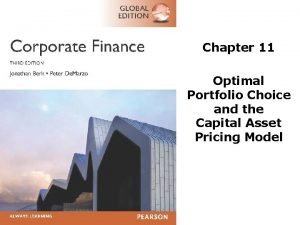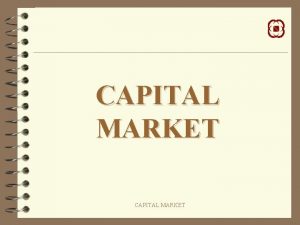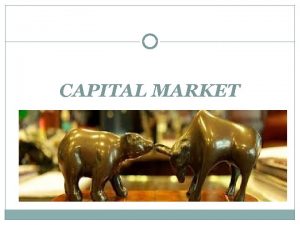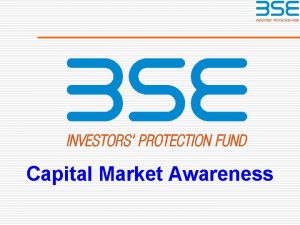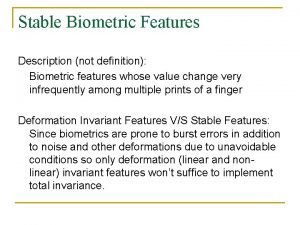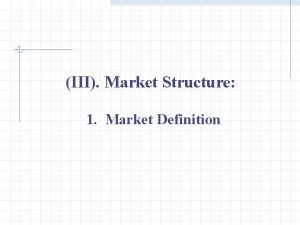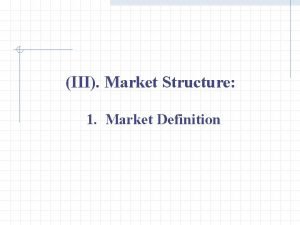CAPITAL MARKET PROLOGUE DEFINITION OF CAPITAL MARKET FEATURES
































- Slides: 32

CAPITAL MARKET Ø PROLOGUE Ø DEFINITION OF CAPITAL MARKET Ø FEATURES Ø MAIN ELEMENTS Ø STOCK MARKET Ø INDIAN ECONOMY AND CAPITAL MARKET AT A GLANCE Ø WHY INVEST IN INDIAN CAPITAL MARKETS? Ø CONCLUSION CAPITAL MARKET

WHAT IS CAPITAL MARKET ? CAPITAL MARKET

PROLOGUE Capital markets are a sub-part of the financial system. Conceptually, the financial system includes a complex of institutions and mechanism which affects the generation of savings and their transfers to those who will invest. It may be said to be made of all those channels through which savings become available for investments CAPITAL MARKET

DEFINATION OF CAPITAL MARKET Capital market can be defined as: “A market for medium to long-term financial instruments. Financial instruments traded in the capital market include shares, and bonds issued by the Australian Government, State governments, corporate borrowers and financial institutions. ” CAPITAL MARKET

In other words: “The capital market (securities markets) is the market for securities, where companies and the government can raise long-term funds. The capital market includes the stock market and the bond market” CAPITAL MARKET

FEATURES Engine of growth Best regulated market Efficient capital securities markets Increasing integration CAPITAL MARKET regulatory framework

MAIN ELEMENTS OF CAPITAL MARMET CAPITAL MARKET

THREE ELEMENTS OF CAPITAL MARKET 4 FINANCIAL ASSETS/INSTRUMENTS/SECURITIES 4 FINANCIAL INTERMEDIARIES 4 FINANCIAL MARKETS CAPITAL MARKET

THE MAIN ELEMENTS FINANCIAL ASSETS/ INSTRUMENTS/SECURITIES The tangible/physical asset is one whose value depends on its physical properties such as buildings, machines, furniture, vehicles and so on. The entity/economic unit that offers the future cash flows is the issuer of the financial ‘instrument’ and the owner of the security is the investor. Depending upon the nature of claim/return, an instrument may be: CAPITAL MARKET

4 DEBENTURE/BONDS: Debenture/bonds is a debt instrument indicating that a company has borrowed certain sum of money and promise to repay it in future under clearly defined terms. 4 TRUST(BOND)INDENTURE: is a complex and lengthy legal document starting the conditions under which a bond has been issued. CAPITAL MARKET

4 DEBENTURE REDEMPTION RESERVE: is a requirement in a debenture indenture providing for the systematic retirement of debenture/bonds prior to their maturity. 4 TERM LOANS: is a loan made by a bank/financial institution to a business having an initial maturity of more than I year: CAPITAL MARKET

EQUITY CAPITAL: Equity capital represents ownership capital, as equity shareholder collectively own the company. They enjoy the rewards and risks of ownership. SOME TERMS: 4 AUTHORISED EQUITY/SHARE CAPITAL: is the number of ordinary share capital that a firm can raise without further shareholder approval. CAPITAL MARKET

ISSUED SHARE CAPITAL: The portion of the authorized capital offered by the company to the investors is the Issued capital. 4 SUBSCRIBED SHARE CAPITAL: is the number of share (capital) outstanding. 4 PPREFERENCE SHARE CAPITAL: is a unique type of long term financing in that combines some of the features of equity as well as debenture. It carries a fixed rate of dividend and it ranks higher than equity as a claimant to the income/assets. CAPITAL MARKET

4 INITIAL PUBLIC OFFERING(IPO): The first issue of the equity share to the public by an unlisted company is called Initial Public Offerings(IPO). CAPITAL MARKET

4 CUMULATIVE(DIVIDEND)PREFERENCE SHARES: are preference shares for which all unpaid dividends in arrears must be paid along with the current dividend prior to the payment of dividends to ordinary shareholders. 4 STRAIGHT PREFERENCE SHARE VALUE/PRICE: is the price at which a preference share would sell without the redemption /call feature. 4 CONVERTIBILITY: Preference share capital may sometimes be convertible partly/fully into equity shares/debentures at a certain ratio during a specified period. A variant in India is cumulative convertible preference shares which combine the cumulative and MARKET convertibility features. It. CAPITAL has, however, been a non-starter so far.

4 CONVERTIBLE DEBENTURES: give the holders the right (option) to change them into a stated number of shares. 4 COVERSION RATIO: is the ratio at which a convertible debenture can be exchanged for shares. 4 CONVERSION PRICE: is the per share price that is effectively paid for the shares as the result of exchange of a convertible debenture. CAPITAL MARKET

4 FINANCIAL INTERMEDIARIES: Financial intermediaries are institutions that channelise the savings if investors into investments/loans. As institutional source of finance , they act as a link between the savers and the investors which results in institutionalization of personal savings. Their main functions is to convert direct financial assets into indirect securities. The indirect securities offer to the individual investor better investor alternative then the direct/primary security by pooling which it is created, for example, units of mutual funds. CAPITAL MARKET

4 FINANCIAL MARKETS: Financial markets perform a crucial function in the financial system as facilitating organizations. Unlike financial intermediaries, they are not a source of funds but are a link and provide a forum in which suppliers of funds and demanders of loans/investments can transact business directly CAPITAL MARKET

The two key financial markets are the money markets and the securities markets: 4 money market: is created by financial relationship between suppliers and demanders of short term funds having maturities of one year or less. 4 securities markets: is a financial relationship created by a number of institutions and arrangements that allows suppliers and demanders of long term funds with maturities exceeding one year to make transactions. CAPITAL MARKET

TYPES OF MARKET 4 PRIMARY MARKET 4 SECONDARY MARKET CAPITAL MARKET

PRIMARY MARKET – The primary market deals with the issue of new instruments by the corporate sector such as equity shares, preference shares and debentures. – Function of primary market. ORIGINATION: is the work of investigation and analysis and processing of new issue proposals. UNDERWRITING: is a form of guarantee that the new issue would be sold by eliminating the risk arising from uncertainty of public response. MARKET DISTRIBUTION: is. CAPITAL the sale of the ultimate investors.

… CONTD 4 Abolition of Controller of Capital Issues in 1992. 4 Constitution of Securities and Exchange Board of India 4 4 4 (SEBI) as the apex regulator. for capital markets. Free pricing of equity. Introduction of book building for raising capital Relaxation in equity dilution norms allowing large unlisted firms esp. in the technology. Progressive changes in the entry norms enabling all companies to access markets. CAPITAL MARKET

… CONTD …. But subject to high disclosure norms and QIB participation 4 Domestic equity raised in last three years at Rs 630 bn is twice the amount 4 Raised during the preceding decade Rs 364 bn 4 Problem of vanishing companies witnessed in mid nineties now well taken Care of with strict disclosure norms and regulatory supervision CAPITAL MARKET

SECONDARY MARKETS … 4 Stock exchanges discharge three vital functions in the orderly growth of capital formation: 1. Nexus between savings and investments 2. Market place and 3. Continuous price formation CAPITAL MARKET

CAPITAL MARKET AT A GLANCE 4 Second fastest growing economies after China with an average annual growth rate of more than 8 per cent in the last three years. 4 Indian companies may issue shares under Employee Stock Option Scheme to its employees who are resident outside. 4 Foreign Institutional Investors are allowed to invest in India under the Foreign Institutional Investment scheme. 4 Private equity is allowed as an alternative form of investment CAPITAL MARKET

… COND 4 NSE (India’s National Stock Exchange) is the third largest in the world in the number of trades after NYSE and NASDAQ. 4 India has 23 small and 2 big stock exchanges. 4 The 2 big stock exchanges (National Stock Exchange and Bombay Stock Exchange) account for 90 per cent of trade. 4 Over 7000 listed companies on the stock exchanges – largest in the world. CAPITAL MARKET

… COND 4 39 mutual funds with over 500 schemes for investment. 4 There are 86 venture capital funds and 54 foreign venture 4 4 4 capital investors. FIIs can invest on behalf of their clients through subaccounts. For normal FIIs, limit for investment in equity is at least 70 per cent while the rest could be invested in debt up to a maximum limit of 30 per cent. 9040 brokers in cash segment and 1064 in derivative segment of the market. 122 investment bankers in the market. 58 under writers to support primary issues. 34 foreign venture capital funds &120 Portfolio managers CAPITAL MARKET

WHY TO INVEST IN INDIAN CAPITAL MARKET ? CAPITAL MARKET

BECAUSE: 4 India’s accounting standards are closer to international standards. 4 SEBI has made corporate governance guidelines mandatory for listed companies. 4 Mutual funds are permitted to invest overseas up to $3 billion. 4 Almost 100 per cent risk free electronic settlement through depository system. CAPITAL MARKET

CONTD…. 4 In India the transactions are totally electronic on a real time basis. 4 Business Week says that of 100 emerging market firms which are rapidly globalizing 21 are Indian firms. 4 Economists project India to become third largest economy in the world by 2040. CAPITAL MARKET

CONCLUSION 4 Indian markets amongst the best regulated markets in the world. 4 Need for greater integration with international markets in terms of capital flows, products and processes 4 Need to introduce new age financial products and to encourage. 4 participation of new age investors. CAPITAL MARKET

THANK YOU CAPITAL MARKET
 Equity capital markets definition
Equity capital markets definition Capital allocation line vs capital market line
Capital allocation line vs capital market line Money market segments
Money market segments What is money market
What is money market Leader challenger follower
Leader challenger follower Segmentation levels
Segmentation levels Internal capital market definition
Internal capital market definition Capital market solutions definition
Capital market solutions definition Chaucer glossary
Chaucer glossary Capital structure features
Capital structure features The term capital structure refers to
The term capital structure refers to Revenue expenditure
Revenue expenditure Fixed capital and working capital
Fixed capital and working capital Difference between capital reserve and reserve capital
Difference between capital reserve and reserve capital Multinational cost of capital and capital structure
Multinational cost of capital and capital structure Difference between capital reserve and reserve capital
Difference between capital reserve and reserve capital Regulatory capital vs economic capital
Regulatory capital vs economic capital Regulatory capital vs economic capital
Regulatory capital vs economic capital Constant capital and variable capital
Constant capital and variable capital Multinational cost of capital and capital structure
Multinational cost of capital and capital structure Economic system features
Economic system features New issue market
New issue market Features of international bond market
Features of international bond market International bond market
International bond market Foreign exchange market features
Foreign exchange market features Features of money market
Features of money market Characteristic of monopoly
Characteristic of monopoly Features of monopoly market
Features of monopoly market Features of money market
Features of money market Capital market theory
Capital market theory Dominant capital allocation line
Dominant capital allocation line Homemade leverage upsc
Homemade leverage upsc Arhousr
Arhousr
